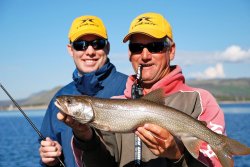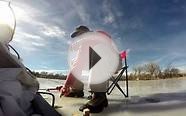Colorado Fishing game
 Many of Colorado’s biggest reservoirs are home to huge lake trout, or mackinaws — as Coloradans call them. Lake trout were planted to provide a big-game species for anglers to target and to provide some control over less desirable species. Not many biologists will admit it, but planting lake trout may have backfired in many waters, eating rainbows and kokanee salmon as fast as the could plant them, and fisheries managers are now scrambling to keep their numbers under control.
Many of Colorado’s biggest reservoirs are home to huge lake trout, or mackinaws — as Coloradans call them. Lake trout were planted to provide a big-game species for anglers to target and to provide some control over less desirable species. Not many biologists will admit it, but planting lake trout may have backfired in many waters, eating rainbows and kokanee salmon as fast as the could plant them, and fisheries managers are now scrambling to keep their numbers under control.
In many lakes, biologists are encouraging, even begging, anglers to keep as many lake trout as they can. The CDOW has even resorted to netting lakers from Blue Mesa Reservoir to head off a fisheries crash. By removing trout and trying to control their numbers, the CDOW hopes to find a balance in fish populations and bolster desirable game fish populations. What was once intended to provide a balanced fishery is now becoming somewhat of a problem for fisheries managers — too many lake trout.
For anglers, Colorado mackinaws are the angler’s version of big game and provide an opportunity to catch the trout of a lifetime. The Colorado state record is over 50 pounds and every year lakers topping 40 pounds are caught in places like Blue Mesa, Granby and other Colorado reservoirs. High water has benefited lake trout reproduction in recent years and exploding Mysis shrimp numbers in some reservoirs provide an unlimited food source for small lake trout. There might not be a better time to target lake trout on Colorado reservoirs.
What follows is a sampling of reservoirs that are sure to provide great trout action this season.
GRANBY RESERVOIR
Lake trout thrive when water levels are high in western reservoirs. When water levels are low, exposed shorelines gather nutrients that are released once the water rises. The food chain gets a jump-start. That’s exactly what has happened in recent years and lake trout populations in several bodies of water have gone bonkers. If you like to catch and eat lake trout, there may be no better time to fish, especially on reservoirs like Granby, Green Mountain and Williams Fork.
“The number of lake trout has just exploded in many of our reservoirs, ” claimed Hot Sulfur Springs Aquatic Biologist Jon Ewert. “Granby probably has two to three times the density of lake trout compared to other rivers with reservoirs right now. Lake trout are having a good time of it in Granby.” For now, the stars are aligning for lake trout.
Mysis shrimp numbers, the main forage for small lake trout, have exploded in Granby. Granby right now is chock full of 15- to 20-inch lakers and they have an unlimited food supply. “The best thing anglers can do right how to help Granby’s lake trout population is to keep a limit of small trout, ” suggested Ewert. Doing so might help prevent a lake trout crash in the years to come.
For now, the trout are thriving on the bounty of Mysis shrimp, but once the trout surpass 20 inches, their diet gradually switches to small fish. Most times that means kokanee salmon and stocked rainbow trout. Right now, there is barely enough kokanee salmon to sustain Granby’s population of trophy lake trout, but biologists are concerned about the long-term outlook. “Right now, there’s plenty of big, trophy trout to go around and they’ve got enough to eat, ” said Ewert. Fish populations in these reservoirs are in a constant state of flux. When one is on the upswing, others are in peril and likely to be on the edge of collapse. Lake trout are flourishing in Granby — for now. Kokanee salmon are disappearing. Part of that is because Mysis shrimp feed on the same population of zooplankton that the kokanee salmon thrive on.
Granby Lake has a long history of fisheries management dating back to just after 1949 when the reservoir was created. Like most reservoirs, 7280-acre Granby was very productive in its early stages. Both kokanee salmon and rainbows were planted around 1951 and lake trout were planted in 1961, and the fish thrived. Adding to the mix, Mysis shrimp were planted in Granby in 1971. Planted to be a food source for the salmon, researchers eventually discovered that the kokanee salmon didn’t eat Mysis shrimp except in rare incidences, but the shrimp did eat the zooplankton that the salmon preferred. Once an extremely productive lake for kokanee salmon, Granby is now managed as a trophy lake trout fishery. But without salmon, you’re not going to have giant lake trout.
Trophy trout guide Bernie Keefe said that fishing for lake trout on Granby couldn’t be better the past year. “The fishing has really been unbelievable, ” exclaimed Keefe. “The fishing is not only been good, it’s been very good. There are big numbers of 15- to 19-inch lakers for those that like to catch lots of fish and there’s still plenty of trophy fish around.” Keefe said ice-out provided some outstanding fishing for both numbers and trophies. Spring finds the lakers in the warming shallows chasing minnows and trout. They stay there until the surface temperature approaches 50 degrees. It’s a great time to cast small crankbaits and stickbaits for trout that may be only in a few feet of water. In the fall, the process is reversed and trout move back into the shallows to feed. “October is great for numbers, ” claimed Keefe. “You can catch 50 fish per day. Most of them will be 15 to 19 inches.”
You might also like










